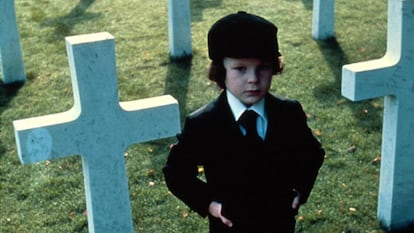From immaculate nuns to superhero exorcisms: Horror cinema prays to the Catholic church
‘The First Omen’ and ‘Immaculate’ update classic religious iconography and make a case for the church’s continued relevance through onscreen terror


“Welcome to your Sunday service.” Ever since its construction was completed in 1929, the Immanuel Presbyterian Church in Los Angeles has been the site of shootings for movies like Sister Act 2 and John Wick — but it has never hosted a project that comes as close to heresy as the one being screened in its neo-Gothic building on a recent evening in March. Actress Sydney Sweeney welcomes a group of devote cinephiles who have come to see a terror film named Immaculate, which has given an R rating due to blasphemy, sacrilegious jokes, blood-soaked violence, nudity and infanticide. A pastor’s association condemned it as morally offensive. For its distributors, this provided yet another excuse to utilize Catholic imagery towards amplifying its marketing campaign.
Sisters who know more than they say, savior exorcists, burning crosses, deformed demons… Immaculate, which premiered on March 22 and stars one of the year’s biggest stars as a nun, is the latest showing from a horror subgenre that, despite societal secularization, continues to supply and transform iconic images. In Immaculate’s case, this is done by utilizing nuncore, an aesthetic that has run the gamut from fashion to pop culture, thanks to our fascination with holy women.
The pioneer of cinema that exploits our fear of the sisterhood was 1922′s Häxan. More recent times have seen the rise (it did more than $600 million at the box office) of The Nun, which forms part of The Conjuring saga, a horror favorite that is based on real-life events. Currently, the niche that nuns occupy within the Catholic horror subgenre has yet other representative in movie theaters: The First Omen, a prequel of the five-film saga in which a battle-ready novice nun fights a clerical conspiracy intent on resurrecting the anti-Christ.
It hardly matters that Catholic orphanages and strict nuns no longer play a central role in the landscape of childhood: their imaginary has not lost its significance, says director Paco Plaza, who has become one of the subgenre’s leading representatives in Spain with his films Verónica and Sister Death. “The fear of the unknown, which we cannot empirically catalog, always remains. It is the seed of all phobias. Catholicism is an inexhaustible source of iconic images, starting with the cross, which in reality was an instrument of torture and is now depicted everywhere. No one would think about wearing a necklace with an electric chair pendant. Catholicism is rich in eternal images.” Why do its symbols remain so potent? “There is an aesthetic fascination with priests and nuns because, even though they coexist in our world, they live with one foot in another reality. There is a certain prosaicness of the supernatural in that. The image of priests in cassocks and nuns in habits impart uniformity. Icons related to physical pain are a potent breeding ground.”

As an example of this, Plaza points to Paco Delgado’s costume design in the latest installment of The Omen. He says the film surprised him, despite its familiar elements. Its saga was born in the ‘70s, with a film featuring a diabolical child protagonist (who would in later editions be incarnated as an anti-Christ by actor Sam Neill) and it has continued to play with the Roman Catholic aesthetic. “For 12 centuries, the only manifestation of art was religious, it had its own brand. Whether we like it or not, it’s our culture, and it appeals to us,” says Plaza, speaking of a church that couched its teachings in terrors that have now been turned into cinematographic icons. It is no coincidence that a rape forms the plot crux of the film by debut director Arkasha Stevenson. Nor that in 1971, when The First Omen is set, a widespread loss of faith was taking place. Which is not to say that the Catholic horror genre isn’t capable of updating its message. Plaza is confident that he could film a nun movie set in the present: “I take it as a challenge.”
Immaculate knows how to address the modern-day digitized world better than the church itself. One of its promotional videos simply shows Sydney Sweeney, who is also the film’s producer, reading a passage from the Bible. Its slight provocation enraged certain believers, who had imagined the blonde, voluptuous actress as a muse of conservatism via her parents’ supposed links to Trumpism. Such internet denizens had previously gone so far as to post that Sweeney’s very cleavage was anti-woke. In another marketing spot for the film, the Euphoria actress accompanied pastors to watch the movie, during which they wore disgusted facial expressions. The film’s imagery has been exploited to the hilt: on April 3, the height of Holy Week, U.S. tickets were diabolically priced at $6.66. Director Michael Mohan confessed that he has intimate knowledge of the world of the church: “I grew up super devout Catholic. There was one weekend where we all brought in tapes and records of albums that we thought had satanic messages on them, and we burned them in effigy,” he told IndieWire.
The film’s marking team provided yet another plot twist when actual reviews by Catholic social media users were put on movie posters: “Diabolical, sacrilegious, pure evil & grossly offensive. It is profane and has a third act that spits in the face of all that is holy. Just…evil,” claimed one such image, in huge letters. The film is already the fourth-highest-grossing release in the history of Neon, its independent distributor. That’s quite the fate for a film whose star’s proposal to make the movie was rebuffed by studios back when she was an unknown. Sweeney found the script in a cast-off pile that no one wanted to produce. At its heart, similar to Saint Maud (2019), its story is about the female body and reproductive rights.
This is not the first time that the faithful have given free publicity to a movie. In 2023, the International Association of Exorcists put out a statement about The Pope’s Exorcist, in which Russell Crowe plays Gabriele Amorth, one of the founders of that Vatican-based paranormal organization, who also serves as the subject of a documentary made by his friend William Friedkin, the creator of The Exorcist. The group called Crowe’s movie “pretentious” and “insulting” to real exorcists. An upcoming sequel to the film has already been announced. Horror, normally cheap to make, is a winning ticket at the box office. And in brand-loving Hollywood, Catholic Church movies have triumphed for generations.
immaculate in theaters now!! pic.twitter.com/k6ywacjTqq
— joe (@mcumagik) March 30, 2024
‘The Exorcist,’ still the king
“The Exorcist changed everything. It didn’t just change the perception of religious film, but also our perception of modern-day priests. They said that the mafia started acting like the gangsters in The Godfather after they saw the movie, and the same thing happened in this case,” says Plaza about the film that influenced all Catholic horror movies that were to follow. “The Exorcist made priests into heroes, an idea that continues to be provocative and risky. It has a touch of movie superheroes fighting against evil.”
Exorcists and savior priests haven’t stopped fighting against the unknown since. The classics are many, but recent examples of cinematic clones also form a lengthy rosary: Devil Inside, The Last Exorcism, Godless: The Eastfield Exorcism (based on real-life events), The Exorcism of Emily Rose, 13 Exorcisms and The Rite. The original saga unleashed a sixth movie with the first installation’s stars, The Exorcist: Believer (2023), on which Universal spent some $400 million that it didn’t get back.
Television has also bet on Catholic terror. In a 2018 series, actress Geena Davis brings back the infamous possessed girl from the 1960s Exorcist, now a mother some 40 years later after the events of the original film. The Catholic horror subgenre appears in Álex de la Iglesia’s 30 Coins, the vampires of Midnight Mass and Evil (the latter a mix of classic rites with more recent terrors such as technology addiction). That same modernity plays a role in The Cleansing Hour, in which an exorcism is the subject of a YouTube live. Going even further afield, the Spanish video game Blasphemous makes use of Holy Week iconography, and has sold over a million copies.
In the end, it’s all in a similar vein: “I think that the trend of spiritual salvation and rituals that supercede the superficial has made a comeback. Both things come together in this kind of cinema,” says Plaza. “The aesthetic is unmatched. That’s how it’s stuck around for so long.” This is how movies transform icons which, in the absence of a weekly tradition of attending Sunday mass, are passed along through tropes that may appear trivial. But if there is a ritualistic cinematic tradition, it is surely the horror genre, which counts with its congregants, its screaming ecstasies, its codified language and passionate devotion. Watching a scary movie continues to be a rite.
Sign up for our weekly newsletter to get more English-language news coverage from EL PAÍS USA Edition
Tu suscripción se está usando en otro dispositivo
¿Quieres añadir otro usuario a tu suscripción?
Si continúas leyendo en este dispositivo, no se podrá leer en el otro.
FlechaTu suscripción se está usando en otro dispositivo y solo puedes acceder a EL PAÍS desde un dispositivo a la vez.
Si quieres compartir tu cuenta, cambia tu suscripción a la modalidad Premium, así podrás añadir otro usuario. Cada uno accederá con su propia cuenta de email, lo que os permitirá personalizar vuestra experiencia en EL PAÍS.
¿Tienes una suscripción de empresa? Accede aquí para contratar más cuentas.
En el caso de no saber quién está usando tu cuenta, te recomendamos cambiar tu contraseña aquí.
Si decides continuar compartiendo tu cuenta, este mensaje se mostrará en tu dispositivo y en el de la otra persona que está usando tu cuenta de forma indefinida, afectando a tu experiencia de lectura. Puedes consultar aquí los términos y condiciones de la suscripción digital.
More information
Archived In
Últimas noticias
Mexico seeks to shore up its defenses following US incursion in Venezuela
Hope gives way to uncertainty among Venezuelan exiles in the US after Maduro’s capture
Cubans look to Venezuela fearfully after Trump’s incursion: ‘We could be next’
The operation in Venezuela to capture Maduro threatens to widen the cracks in the MAGA movement
Most viewed
- Alain Aspect, Nobel laureate in physics: ‘Einstein was so smart that he would have had to recognize quantum entanglement’
- Gilles Lipovetsky: ‘If you want to live better and fall in love, take Prozac, don’t look to philosophy’
- Alvin Hellerstein, a 92-year-old judge appointed by Bill Clinton, to preside over Maduro’s trial in New York
- Cuba confirms death of 32 of its citizens in the US attack against Venezuela
- Why oil has been at the center of Venezuela-US conflicts for decades










































